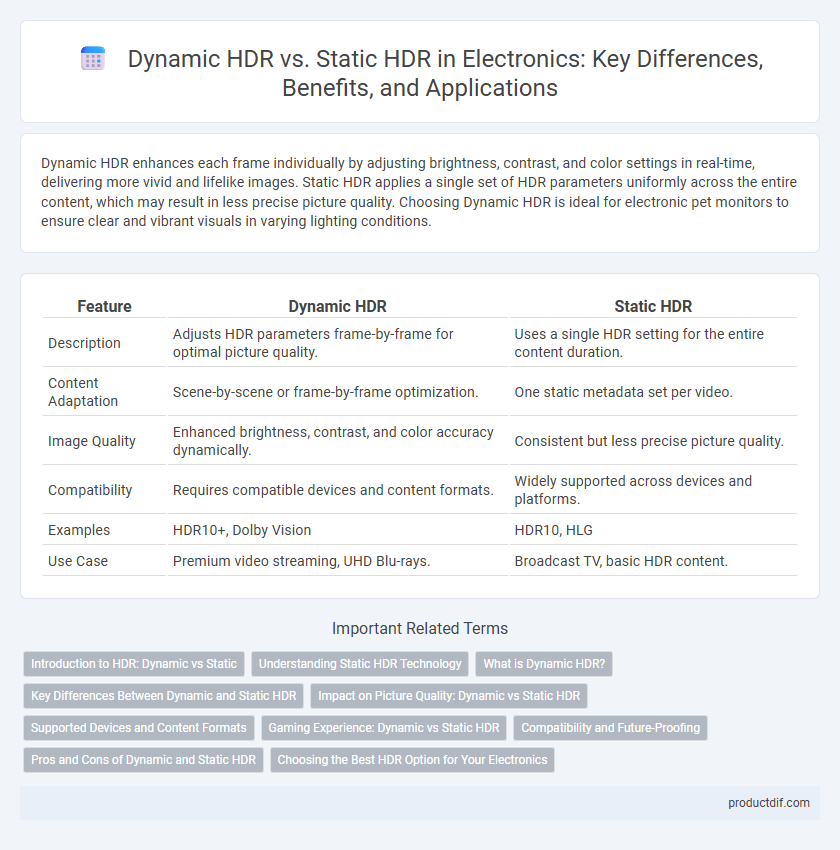Dynamic HDR enhances each frame individually by adjusting brightness, contrast, and color settings in real-time, delivering more vivid and lifelike images. Static HDR applies a single set of HDR parameters uniformly across the entire content, which may result in less precise picture quality. Choosing Dynamic HDR is ideal for electronic pet monitors to ensure clear and vibrant visuals in varying lighting conditions.
Table of Comparison
| Feature | Dynamic HDR | Static HDR |
|---|---|---|
| Description | Adjusts HDR parameters frame-by-frame for optimal picture quality. | Uses a single HDR setting for the entire content duration. |
| Content Adaptation | Scene-by-scene or frame-by-frame optimization. | One static metadata set per video. |
| Image Quality | Enhanced brightness, contrast, and color accuracy dynamically. | Consistent but less precise picture quality. |
| Compatibility | Requires compatible devices and content formats. | Widely supported across devices and platforms. |
| Examples | HDR10+, Dolby Vision | HDR10, HLG |
| Use Case | Premium video streaming, UHD Blu-rays. | Broadcast TV, basic HDR content. |
Introduction to HDR: Dynamic vs Static
High Dynamic Range (HDR) enhances video quality by expanding contrast and color accuracy, with Static HDR applying uniform metadata throughout the content, resulting in consistent brightness and color levels. Dynamic HDR adjusts metadata scene-by-scene or frame-by-frame, optimizing luminance and color performance for each moment, thus delivering more precise and vivid visuals. Popular Dynamic HDR formats include Dolby Vision and HDR10+, while HDR10 represents the most common Static HDR standard.
Understanding Static HDR Technology
Static HDR technology applies a single, fixed HDR tone mapping curve throughout the entire video, enhancing brightness and color contrast based on pre-calibrated metadata settings. Unlike Dynamic HDR, which adjusts the tone mapping on a scene-by-scene or frame-by-frame basis, Static HDR offers a consistent HDR experience but may miss optimizing visual details in varying lighting conditions. Common implementations of Static HDR include HDR10, where static metadata defines peak brightness and color gamut for the whole content.
What is Dynamic HDR?
Dynamic HDR enhances video quality by adjusting brightness, contrast, and color on a scene-by-scene or frame-by-frame basis, delivering more accurate and vivid visuals compared to Static HDR. It uses metadata that changes dynamically throughout the content, optimizing each frame individually to preserve details in both dark and bright areas. This technology results in a more immersive viewing experience with improved depth and realism in electronic displays.
Key Differences Between Dynamic and Static HDR
Dynamic HDR adjusts brightness, contrast, and color on a scene-by-scene or frame-by-frame basis, offering enhanced picture quality and more accurate image reproduction compared to Static HDR, which uses a single set of metadata for the entire content. Key differences include Dynamic HDR's ability to optimize visual details in varying lighting conditions and its support for formats like HDR10+ and Dolby Vision, while Static HDR, such as HDR10, applies uniform settings regardless of scene complexity. This results in Dynamic HDR delivering deeper blacks, brighter highlights, and improved color accuracy, making it superior for modern high-end displays and streaming platforms.
Impact on Picture Quality: Dynamic vs Static HDR
Dynamic HDR analyzes each scene or frame individually, optimizing brightness, contrast, and color to deliver more accurate and vivid picture quality. Static HDR applies a single tone mapping curve for the entire content, resulting in less precise reproduction of dark and bright details. This scene-by-scene optimization in Dynamic HDR enhances visual depth and realism, significantly improving overall image quality.
Supported Devices and Content Formats
Dynamic HDR delivers enhanced picture quality by adjusting brightness and contrast scene-by-scene or frame-by-frame, supported primarily on advanced 4K UHD TVs, newer gaming consoles like Xbox Series X, and premium streaming devices. Static HDR, such as HDR10, is widely compatible with a broader range of devices including older 4K TVs, Blu-ray players, and most streaming services but applies the same HDR metadata throughout the entire content. Content formats supporting Dynamic HDR include HDR10+ and Dolby Vision, while Static HDR is typically limited to HDR10 and HLG formats.
Gaming Experience: Dynamic vs Static HDR
Dynamic HDR enhances gaming experience by adjusting brightness and contrast scene-by-scene or frame-by-frame, delivering more vivid and lifelike visuals. Static HDR applies a single tone-mapping curve to the entire game, resulting in less precise color and brightness representation. Gamers benefit from dynamic HDR's ability to reveal finer details in both dark and bright areas, improving immersion and competitive visibility.
Compatibility and Future-Proofing
Dynamic HDR enhances compatibility by adjusting brightness and contrast frame-by-frame, ensuring optimal picture quality across diverse content and devices, while Static HDR applies a single setting per video, limiting adaptability. Devices supporting Dynamic HDR like HDR10+ and Dolby Vision offer better future-proofing as streaming services and ultra HD Blu-rays increasingly adopt dynamic metadata standards. Choosing Dynamic HDR compatible displays prepares users for evolving content demands, providing superior color accuracy and improved viewing experiences over time.
Pros and Cons of Dynamic and Static HDR
Dynamic HDR enhances picture quality by adjusting brightness and contrast on a scene-by-scene basis, resulting in more accurate color and better detail in both dark and bright areas. Static HDR uses a single tone mapping curve for the entire content, which is simpler but may cause some scenes to appear less vibrant or detailed. Dynamic HDR supports standards like HDR10+ and Dolby Vision, offering superior visual performance, while Static HDR, such as HDR10, is more universally compatible and easier to implement.
Choosing the Best HDR Option for Your Electronics
Dynamic HDR adjusts brightness and color on a scene-by-scene basis, delivering more precise and vibrant visuals compared to Static HDR, which applies a single tone mapping curve for the entire content. Electronics with Dynamic HDR support, such as displays compatible with HDR10+ or Dolby Vision, offer enhanced contrast and color accuracy, making them ideal for gaming and cinematic experiences. Choosing the best HDR option depends on your device compatibility and content preferences, with Dynamic HDR providing superior image quality for varied viewing scenarios.
Dynamic HDR vs Static HDR Infographic

 productdif.com
productdif.com